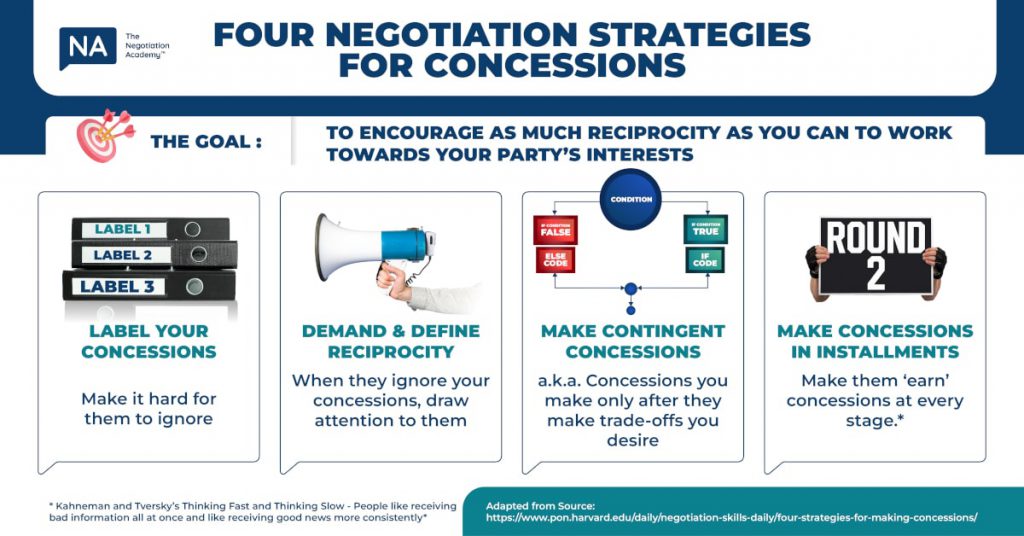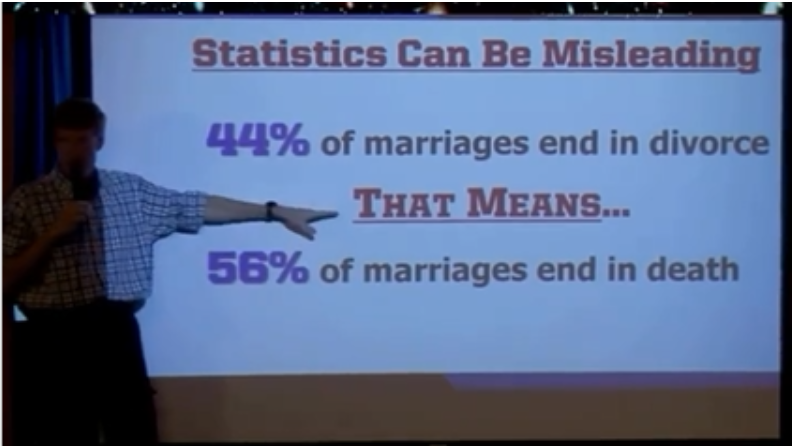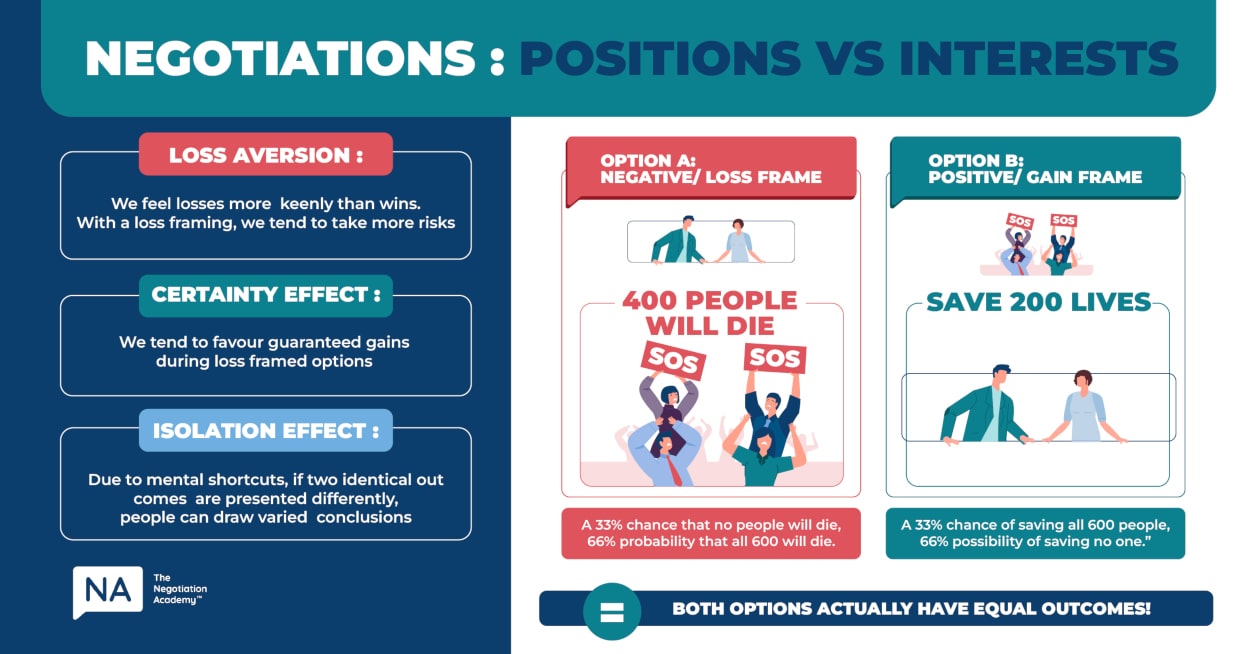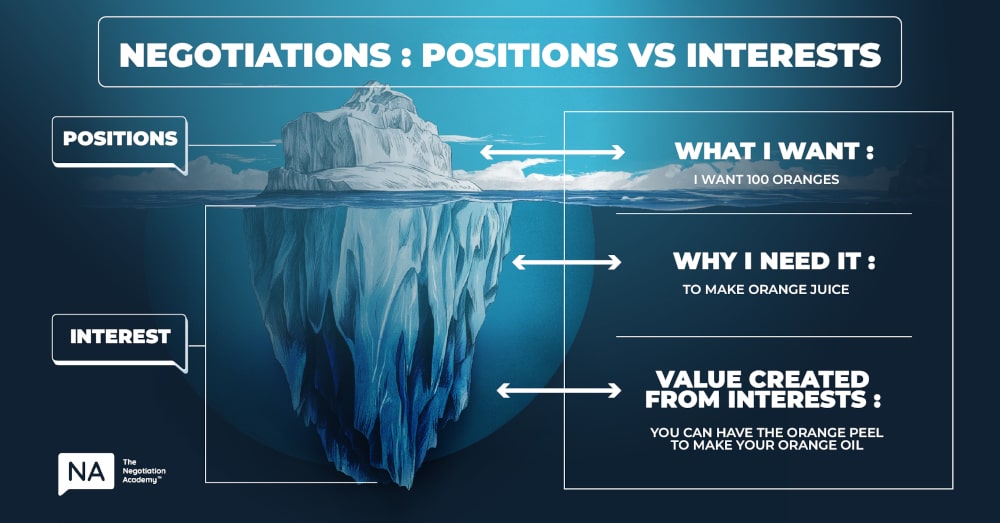Negotiation Skills: Concessions in Negotiation – Strategic Approaches for Win-Win Solutions

Have you noticed that great conversations have a fair amount of give and take?
Each party takes turns speaking and listening to the other. When respect is given, respect is received.
Negotiations are a lot like conversations, only with higher stakes. If nothing is given at first, nothing is received. And this is where concession strategies come in.
A concession is when you offer something during negotiations to move closer to a mutually beneficial outcome. However, how you make concessions affects the outcome of the negotiation a lot. As with conversations, saying the right thing the wrong way can lead to disaster.
For example, if you give them everything they want too soon, you might leave your counterparty with the Winner’s Curse. The winner’s curse happens when the counterparty feels they might have been shortchanged due to winning way too quickly.
Situations like getting the winner’s curse are best avoided. A well-prepared concession strategy can build trust, improve outcomes, and foster long-term partnerships.
Concessions and Subjective Satisfaction
A key point in negotiation strategy is that how you get to a deal is just as important as what the outcome is. When people feel that they worked hard for each concession, they experience greater subjective satisfaction – even if you were planning for them to achieve that outcome from the very beginning.
Daniel Kahneman and Amos Tversky, famous for their work on Prospect Theory teach us that how information is delivered affects how they will react. People prefer receiving bad news all at once, but enjoy receiving good news gradually. You can find out more about Kahneman and Tversky’s work on prospect theory here.
Making the counterparty work for their concessions gives them the subjective satisfaction of continually winning small victories—avoiding the Winner’s Curse.
Anchoring and Concessions
The first set of ideas, asks and thoughts in any conversation can have a disproportionately high influence on he rest of the negotiation. This is called the anchoring effect and is proven in many, many studies. Setting the first anchor can define the entire bargaining range before we can begin providing concessions. You can also find out more about anchoring here.
If your counterparty takes a robust initial position, you should bring their price closer to your reserve price before presenting your own counteroffer.
This creates a more favorable range for subsequent concessions or the zone of possible agreement, making it easier to get to your target outcome.
Your reactions can also help to shift the anchor. You could intentionally ‘flinch’ at their starting anchor to see if they can move it closer to what you are going for before you counter-offer. This gives them the impression that they are winning.
The reverse is true. If we make the first offer, we will want to offer close to our counterparty’s limit or reservation price. The limit price is the highest price at which the buyer is willing to still buy the item and the lowest price at which a seller is still willing to sell the item.
Proper Preparation is Key
If you’ve prepared well, you should have a decent estimate of your limit price and your counterparty’s limit price.
You should also look out for what you can provide as concessions to them. The ideal scenario is that it costs your party very little while being highly valuable to your counterparty to help build trust. Conversely, you will want to list out the concessions you want from their side as well. Our preparation checklist provides more information.
Now that this has been established, we can now check out the concession strategies.
Four Key Concession Strategies:1

- Label Your Concessions: Your counterparty has the incentive to ignore your concessions so we should not assume that they will recognize your concessions without making it clear.
By explicitly labeling your concessions so that they will not be ignored.- Example: “I am willing to lower the price by 5%, but I need you to commit to a larger order.”
- Demand Reciprocity: Every concession should come with an ask. You’re not giving something for nothing—clearly ask the counterparty to reciprocate with their own concession.
- Example: “I’ve agreed to shorten the delivery time. In exchange, I’ll need a longer-term contract.”
- Use Contingent Concessions: In situations where trust is low, make your concessions conditional on specific actions. This ensures that you don’t give away leverage prematurely.
- Example: “I’ll lower the price on this product, but only if you agree to a two-year service contract.”
- Installment Concessions: Just like with good news, delivering concessions in smaller increments can create the impression that the other side is “winning” more throughout the negotiation. This maintains positive momentum and keeps the other party engaged.
- Example: Start by conceding on less significant terms and work toward bigger concessions over time.
Also, Take Note of Cultural Differences in Concession Strategies
Different cultures treat bargaining differently. In some cultures, aggressive bargaining is expected, and concessions are part of a back-and-forth exchange. In others, concessions may be seen as a sign of weakness, and a more straightforward approach is valued.
Before entering a negotiation, it’s crucial to understand the counterparty’s cultural norms. If aggressive bargaining is common, come with a well-structured concession plan. If not, be more strategic about the concessions you make and when you make them.
Conclusion
In the end, nothing given means nothing gained.
When you use concessions strategically, you can transform negotiations from deadlocks into potential win-win scenarios.
By coming prepared with limit prices, what you can concede and ask for, along with the strategies you can use to encourage reciprocity, we can work towards a deal where both parties feel satisfied. Remember to make your counterparty work for it, so they walk away feeling like they’ve won every concession.
Joining one of our courses will put you on par with over 10,000 leading lawyers from Fortune 500 companies to Tier 1 law firms globally, boosting your negotiation skills to new heights.
If you want to see how these biases happen in real life, try one of our online courses or join a tailor-made live training session for your organization!
—
If you enjoyed this content, join our free 10-week Email course on the fundamentals of Collaborative and Competitive Negotiation skills by clicking HERE.
Each week, you will get a bite-size email unpacking some of the most fundamental negotiation concepts that you can apply in your everyday negotiations, along with an insight video and book recommendation to go further in areas you want to learn more about.
Additional reading:









